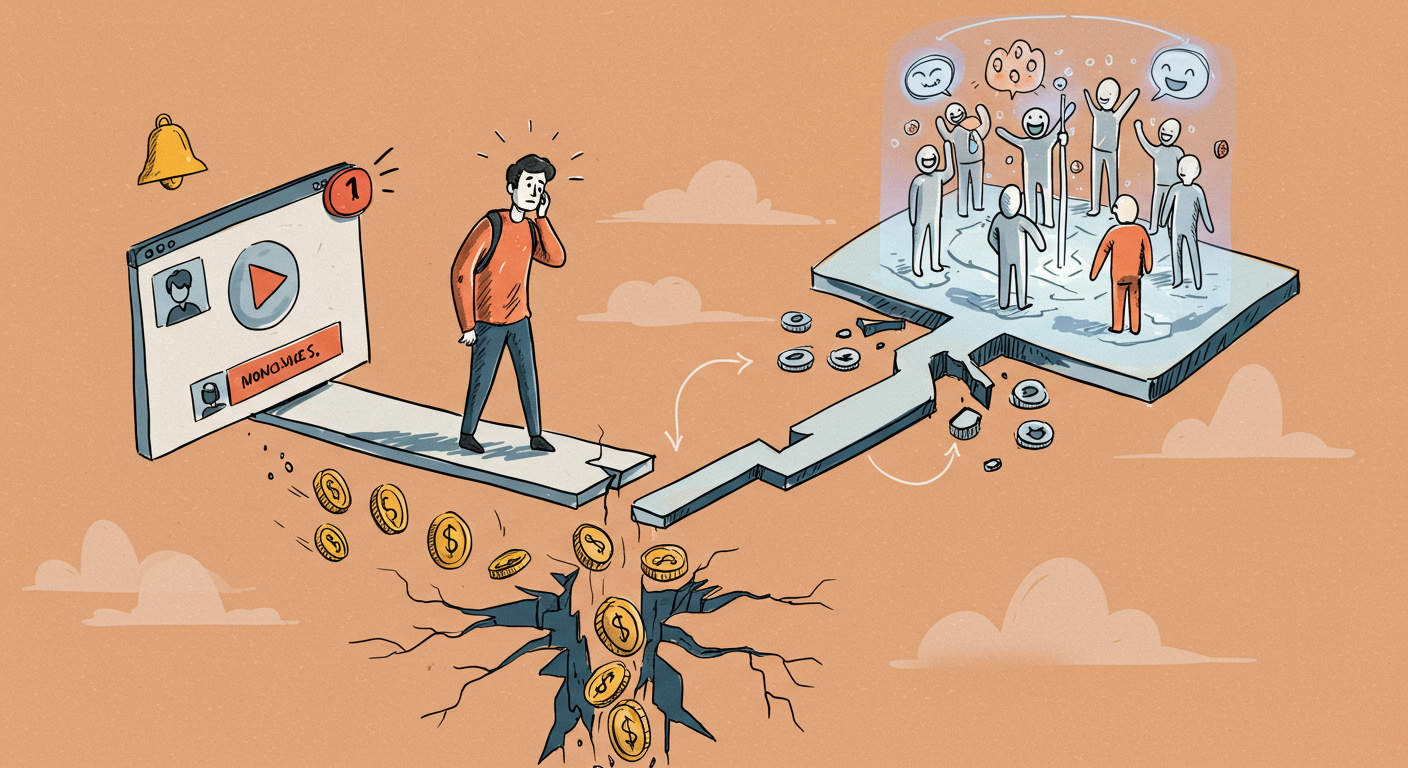
For many influencers, brand deals and ad revenue have become the default pathways to turning online fame into cash flow. But while a sponsored post might bring a respectable paycheck, the reality is that inconsistent partnerships and fluctuating platforms can leave you feeling like you’re on shaky ground. One month you’re inundated with offers; the next, you’re facing a drought. In a social media landscape where algorithms shift and audiences grow numb to constant ads, relying solely on sponsorships can quickly morph into a treadmill you can’t get off.
That’s where the power of digital community building comes in. Instead of chasing one-off deals, influencers are increasingly discovering the value of turning their audience into a cohesive, thriving digital space. This approach not only diversifies revenue streams but also nurtures a sense of belonging among followers—transforming them from passive scrollers into active participants.
If you’ve ever wondered how to build influencer community that truly lasts, the answer lies in ownership and connection. It starts with creating a dedicated space—outside the noise of traditional platforms—where your followers can engage more meaningfully. Whether it’s offering exclusive content, running live events, or launching a membership hub, the focus should be on consistent, authentic value. This kind of direct interaction builds loyalty and opens up new monetisation pathways far beyond one-time brand deals.
In the sections ahead, we’ll explore why this shift is so critical for long-term success, the key benefits of owning your own platform, and the actionable steps to transition from brand-dependent influencer to community-focused entrepreneur.
1. The Problem with Platform-Dependent Monetisation

Social media might look like an influencer’s playground, but the truth is that algorithms and platform rules dictate much of what your followers actually see. Whether it’s Facebook limiting organic reach or YouTube regulating certain categories, you’re ultimately at the mercy of someone else’s policies. More concerningly, even if a platform offers monetisation tools—like ad splits or paid subscriptions—those features can be revoked or altered at any moment. Essentially, you’re renting space rather than owning it.
Sponsorships and brand partnerships, while sometimes lucrative, also fail to provide genuine income stability. You might land a high-paying partnership for one quarter, only to find the brand shifts focus or budgets get slashed in the next. This unpredictability isn’t just stressful; it can also undermine long-term growth strategies. Instead of planning months or years ahead, you’re stuck hoping your next deal will materialise in time to cover expenses. Meanwhile, excessive sponsored content can erode follower trust if every post becomes a commercial—potentially damaging your reputation in ways that are hard to reverse.
2. What Makes a Digital Community Different
A typical influencer-audience relationship is one-directional: you broadcast, and they watch. In a digital community, however, the dynamic shifts to genuine two-way interaction. Members chat with each other, offer feedback, and participate in a shared culture—rather than merely liking or commenting on your posts. This sense of belonging and collective identity fosters an environment where people stick around for more than just fleeting entertainment.
Communities thrive on mutual exchange, which can be emotional or informational. Members might share personal anecdotes, tips, or resources tied to your niche, while you or your team facilitate meaningful discussions. In turn, participants feel heard and valued, forging deeper loyalty. From a business perspective, this communal bond is extremely powerful. People are far more inclined to support—and even promote—a platform they find personally enriching. Whether that support comes in the form of direct payments, event attendance, or product purchases, it stems from a place of genuine engagement rather than passive viewership.
3. The Core Benefits of Building Your Own Community

One of the most compelling arguments for creating your own digital community is having full ownership of your audience. When you rely solely on social media platforms, your followers are just a click away from disappearing if an algorithm changes or a platform decides to suspend your account. In contrast, running a private forum, a membership site, or any other platform you control means you hold the keys—you decide what content gets highlighted, how members interact, and how you engage them.
Another significant advantage is greater creative freedom. In a sponsor-driven model, you’re beholden to brand guidelines and content restrictions. A single misalignment in tone or style can create friction. But in a community that you design, there are no such external limitations. You can explore new formats, experiment with sensitive topics, or dive into niche interests without worrying about losing a contract. Your community’s needs and feedback guide your creative direction, allowing for a more authentic and fulfilling process.
Finally, there’s the enduring value of relationship building. Traditional influencer strategies often revolve around short bursts of visibility—like a big campaign push or a viral post. A community, on the other hand, sustains momentum over the long haul. Members return to see what’s new, participate in discussions, and offer their own insights. This ongoing engagement typically results in higher loyalty, a stronger brand identity, and a much clearer picture of your audience’s evolving preferences.
4. Monetisation Paths That Go Beyond Sponsored Content
When you own a community, monetisation options open up in ways that simply aren’t possible with a feed-dependent strategy. Below are a few approaches that can diversify your revenue streams while adding real value to your followers:
- Membership Subscriptions
By offering tiered access—such as a basic free tier and a paid premium level—you create predictable, recurring revenue. Premium subscribers could receive perks like exclusive AMA (Ask Me Anything) sessions, early access to new content, or in-depth guides not available to casual followers. - Exclusive Events or Q&As
Hosting live virtual workshops or group video chats can be incredibly lucrative. Members pay for a ticket or monthly fee to access these closed-door sessions, where they interact with you and each other in real time. These events often generate a sense of intimacy and exclusivity that fosters deeper community bonds. - Premium Content Hubs
A private repository of articles, videos, or podcast episodes can become a centrepiece of your monetisation strategy. Imagine a content library with how-to guides, personal case studies, and advanced tips that die-hard fans are willing to pay for. This not only boosts income but also positions you as a trusted authority in your niche. - Workshops, Digital Products, or Experiences
Beyond gated access, consider creating and selling digital products—like e-books, checklists, templates, or online courses—directly to community members who already see you as an expert. For more immersive engagement, you could offer one-day virtual retreats, masterminds, or even in-person meetups, turning your community’s trust into memorable shared experiences.
These models give you recurring and diversified revenue rather than relying on irregular sponsor paychecks. Importantly, they’re also designed to align with your audience’s interests, ensuring members feel they’re investing in something genuinely beneficial.
5. Real-World Examples of Influencer Communities

The shift to community-based monetisation isn’t just hypothetical; many influencers have already made the leap. Take fitness creators who’ve moved beyond Instagram workout snippets to run private online training clubs. In these clubs, members receive personalised workout plans, dietary advice, and exclusive group challenges, all of which nurture camaraderie and accountability. The result? Recurring income for the influencer, plus a motivated fan base that sticks around for the long haul.
Another example involves writers and content creators who’ve launched member-only newsletters or micro-communities. A writer might pen weekly deep dives into specific topics, providing further reading lists or exclusive behind-the-scenes insights. Through paid subscriptions, these creators avoid the pitfalls of ad-driven revenue and can focus on producing thoughtful, high-quality content. Likewise, influencers running digital clubs or mastermind sessions have transformed casual followers into dedicated cohorts who pay for deeper education and networking opportunities. Not only does this generate robust income, but it also forges stronger ties among members—who often become ambassadors for the influencer’s brand, services, or future ventures.
Across all these examples, the unifying theme is a stronger brand identity and more predictable income. Rather than scattering effort across every social platform in hope of catching the next big sponsorship, these influencers focus on cultivating a deeply engaged community that’s willing to invest in meaningful ways.
6. How to Transition From Followers to Community Members
Shifting your followers from passive observers to active participants requires a clear game plan. Below are some tangible steps to help you make the move:
- Define a Clear Value Proposition
Ask yourself: “What do people gain by joining my community?” Whether it’s access to exclusive content, in-depth discussions, or a supportive peer network, ensure you articulate these benefits plainly. - Develop the Right Platform
Different tools cater to different needs. Develop a customised digital community platform that aligns to the value proposition and your audience’s preferences. - Offer Early Access or Founding Member Perks
Incentivise your most loyal followers to join first, granting them special titles, badges, or exclusive sessions. This not only gives your community some immediate activity but also fosters a sense of insider status that can attract more members over time. - Use Storytelling and Transparency
Authenticity fuels community growth. Share the reasoning behind your transition: your desire to provide higher-value content or create a space that algorithms can’t disrupt. This transparency helps followers understand why you’re embarking on this journey and why they should follow suit.
Remember, quality over quantity is vital in any community. You don’t need thousands of members on day one. A focused group of committed individuals who truly believe in your vision is far more valuable than a large but disengaged audience.
7. Common Mistakes to Avoid When Building a Community

Building a digital community can be incredibly rewarding, but it’s easy to stumble if you’re not aware of the common pitfalls. Here’s what to watch out for:
- Starting Too Broad
A successful community has a focused niche or purpose. If your theme is too vague—like “wellness,” “beauty,” or “business”—you risk attracting an audience with clashing interests and losing momentum fast. - Treating the Community Like a Broadcast Channel
A community is meant for genuine interaction, not just top-down announcements. If members sense it’s just another platform for you to self-promote, they’ll quickly lose interest. Spark conversations, ask questions, and encourage members to share their own stories. - Lack of Exclusive Value
If your community content duplicates what people can get for free on Instagram or YouTube, there’s no incentive to join. Make sure your membership benefits are unique—like deeper insights, early previews, personal feedback, or even direct engagement opportunities with you.
Steering clear of these missteps will not only help your community grow but also position it as an integral part of your influencer brand, rather than just an experimental add-on.
Conclusion – Understanding How to Build Influencer Community for Lasting Impact

In an ever-evolving social media landscape, relying on brand deals and ad revenue can feel like building on borrowed land. Platforms change their rules overnight, and sponsors come and go, leaving you with a constant cycle of uncertainty. A thriving digital community, on the other hand, gives you true ownership over your audience, content, and long-term financial outlook.
By cultivating a space where followers interact, share, and learn from each other, you’re no longer just an influencer—you become a community leader. The result is a sustainable, meaningful ecosystem that not only diversifies your income but also provides value to everyone involved. Whether it’s recurring membership fees, exclusive events, or digital products, your monetisation strategies gain depth, authenticity, and resilience.
If you’re ready to step off the sponsorship treadmill, now is the moment to invest in a community-driven future. It’s a shift that requires planning, a strong vision, and genuine care for your supporters, but the payoff is considerable: consistent revenue, deeper engagement, and a platform truly under your control. In other words, it’s the path from fleeting influence to lasting ownership—one that can reshape your online brand for years to come.
